Sustainable business practices are now key for companies around the world. Certifications help drive environmental responsibility and corporate accountability. They give businesses a clear way to show they care about the planet.
Today, companies see sustainability as essential, not just a choice. These certifications offer a way to measure and prove environmental efforts. They help track progress and make real changes for the environment.
Businesses are learning that getting certified brings many benefits. It helps reduce harm to the environment and boosts a company’s image. It also draws in customers who care about the planet and gives a competitive edge in the global market.
Key Takeaways
- Certifications provide structured frameworks for sustainable business practices
- Environmental accountability becomes measurable through standardized programs
- Sustainability certifications drive corporate reputation and market positioning
- Companies gain competitive advantages by implementing robust ecological strategies
- Transparent measurement enables continuous environmental improvement
Understanding Certifications on Promoting Sustainable Practices
Today, businesses know how vital sustainable practices are for lasting success. Green Business Certification is a key way for companies to show they care about the environment and do things right.
Types of Sustainability Certifications
There are many ways for companies to prove their green efforts. These certifications help measure and boost their environmental impact in various sectors.
- Environmental Management System (EMS) Certifications
- Carbon Neutrality Certifications
- Waste Reduction Credentials
- Energy Efficiency Recognitions
Core Components of Green Certifications
Good Green Business Certification programs focus on a few main areas. They check how well a company does in being green.
| Certification Component | Key Performance Indicators |
|---|---|
| Energy Consumption | Renewable energy usage, efficiency metrics |
| Waste Management | Recycling rates, waste reduction strategies |
| Supply Chain Sustainability | Ethical sourcing, carbon footprint assessment |
Certification Standards and Requirements
To get Green Business Certification, a company must show it’s serious about the environment. It needs to document its green efforts, pass third-party checks, and keep getting better.
- Detailed environmental impact assessment
- Comprehensive documentation of sustainable practices
- Independent verification process
- Regular performance monitoring
Companies serious about being green can use these frameworks. They help make real environmental changes and show they’re responsible to everyone involved.
The Evolution of Green Business Certification Systems
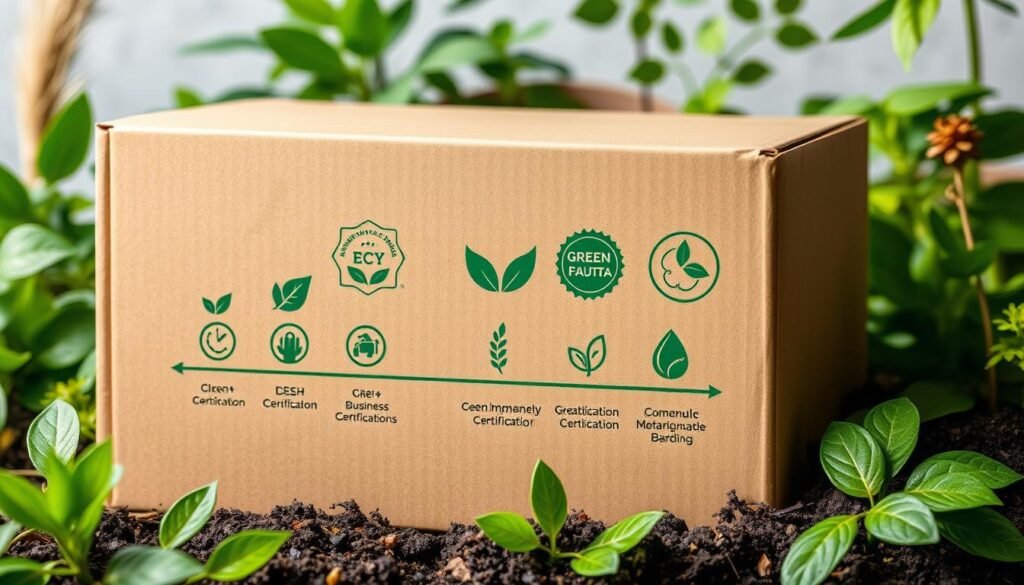
Green Business Certification has changed a lot over the years. It started with simple rules to follow and now it’s all about detailed, big plans for the planet. This change shows how companies are now more aware of the environment.
In the late 20th century, the first green certifications came out. They mainly focused on cutting down waste and using less energy. Now, we have much more complex systems that help companies really make a difference.
- 1990s: Initial environmental management standards
- 2000s: More detailed sustainability goals
- 2010s: Technology helped make certifications better
- 2020s: Now, we have global, all-encompassing plans
New tech has made Green Business Certification better. It lets companies track their green efforts more accurately and in real time. Now, thanks to digital tools, it’s easier for businesses to follow green practices and show their progress.
| Certification Era | Key Characteristics | Primary Focus |
|---|---|---|
| Early Phase (1990-2000) | Basic Environmental Compliance | Waste Reduction |
| Intermediate Phase (2001-2010) | Expanded Sustainability Metrics | Energy Efficiency |
| Advanced Phase (2011-2020) | Technology-Driven Assessments | Comprehensive Impact Measurement |
| Current Phase (2021-Present) | Global Sustainability Integration | Holistic Environmental Strategy |
Today’s Green Business Certification looks at more than just the environment. It also considers social and governance issues. These advanced systems help companies show they’re serious about being green. They also give clear goals for how to improve.
How Environmental Management Systems Shape Business Operations
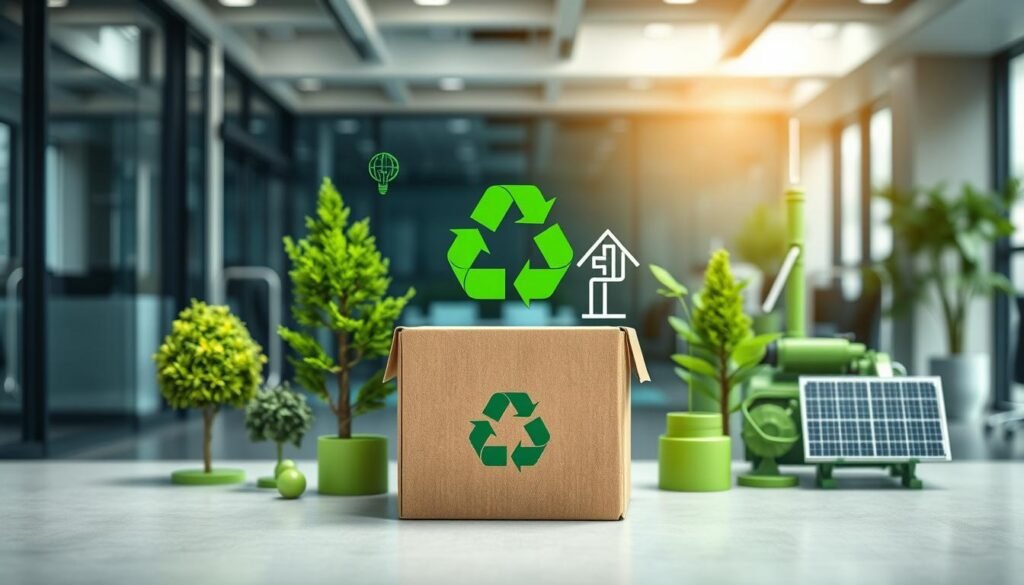
Environmental Management Systems (EMS) have changed how businesses think about sustainability and efficiency. These systems help companies manage their environmental impact and keep improving.
Today, companies see EMS as more than just rules to follow. They are strategic tools that help manage and reduce environmental impacts. This approach is key to business operations.
ISO 14001 Implementation Benefits
- Enhanced corporate reputation and credibility
- Reduced operational costs through resource efficiency
- Improved regulatory compliance
- Systematic approach to environmental risk management
Performance Metrics and Monitoring
Good EMS systems need strong tracking. Companies use detailed monitoring to track important environmental signs.
| Metric Category | Key Performance Indicators | Measurement Frequency |
|---|---|---|
| Energy Consumption | kWh per production unit | Monthly |
| Carbon Emissions | CO2 equivalent tons | Quarterly |
| Waste Management | Recycling percentage | Quarterly |
Continuous Improvement Processes
The heart of EMS is its focus on getting better all the time. Companies create cycles to check and update their environmental plans.
- Regular environmental impact assessments
- Data-driven strategy refinement
- Stakeholder feedback integration
- Technology and innovation adoption
By using EMS, businesses can turn environmental problems into chances for growth, innovation, and efficiency.
Corporate Social Responsibility and Certification Programs
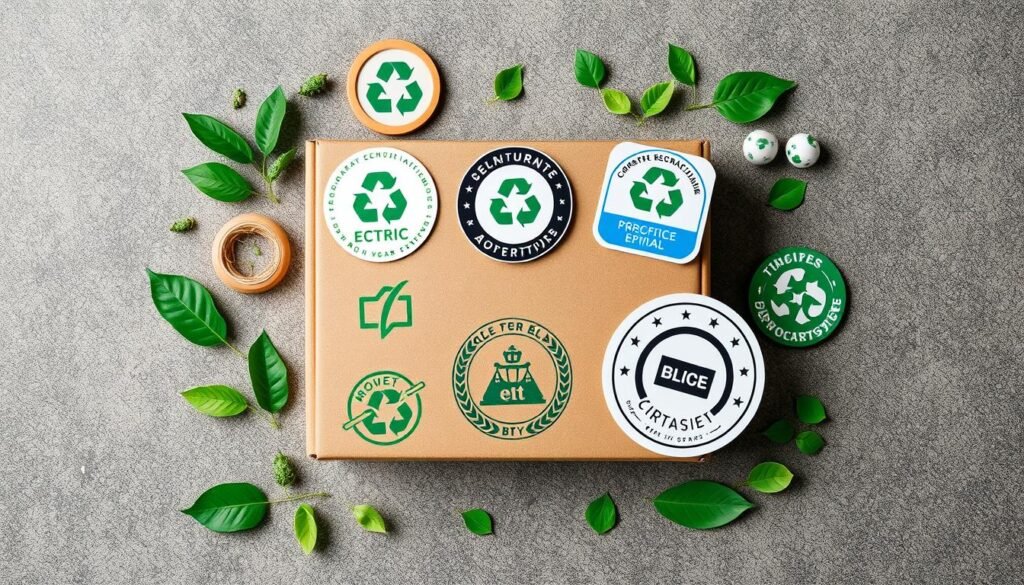
Corporate Social Responsibility (CSR) is now key in business plans. Companies see their influence goes beyond just making money. CSR Credentials show a company’s commitment to being green and fair.
Certification programs are great for proving a company’s CSR work. They offer solid proof of a company’s efforts in social and environmental areas. Businesses use these certifications to:
- Improve their brand image
- Gain trust from stakeholders
- Show real social and environmental impact
- Stand out from competitors
Getting CSR Credentials means you can report openly and get third-party approval. This makes a company look good by showing it’s serious about being green. It proves they really care about sustainable practices.
Good CSR strategies cover many areas of responsibility. Companies need strong plans that include caring for the environment, treating workers right, and helping the community.
| CSR Certification Focus Areas | Key Outcomes |
|---|---|
| Environmental Sustainability | Lower Carbon Footprint |
| Labor Ethics | Better Worker Conditions |
| Community Investment | Good Social Impact |
By getting CSR Credentials, companies turn their green promises into real, checkable facts. These certifications are smart moves for lasting business success and helping society.
Carbon Footprint Reduction Through Certified Programs

Today, businesses are working hard to lessen their environmental harm. They use Carbon Footprint Reduction Diplomas and certification programs to do this. These tools help companies understand and cut down their carbon emissions.
Companies wanting to lower their carbon footprint can use special certification programs. These programs help track and reduce greenhouse gas emissions. They give a clear plan for businesses to follow for sustainability.
Measuring Carbon Emissions
Getting the right numbers on carbon emissions is key to reducing them. Companies use advanced tools and methods to measure their environmental impact:
- Greenhouse gas protocol assessments
- Comprehensive emission tracking systems
- Advanced carbon accounting software
Implementation Strategies
Good Carbon Footprint Reduction Diplomas have smart ways to lessen environmental harm:
- Do a detailed emissions baseline assessment
- Set clear reduction goals
- Use energy-saving technologies
- Change how things are done
Verification Processes
| Verification Stage | Key Activities | Certification Level |
|---|---|---|
| Initial Assessment | Comprehensive emissions inventory | Baseline Certification |
| Reduction Planning | Strategic intervention development | Intermediate Certification |
| Ongoing Monitoring | Continuous performance tracking | Advanced Certification |
Third-party verification makes sure carbon reduction efforts are real and accurate. These strict checks prove a company’s dedication to being green and caring for the environment.
Eco-Friendly Manufacturing Standards and Compliance
Eco-Friendly Manufacturing Certificates are key for sustainable practices in industry. Companies all over the world are getting these certifications to show they care about the environment and do things well.
Important standards guide businesses in making their manufacturing greener. These standards help cut down on environmental harm while keeping quality high.
- Cradle-to-Cradle Certification
- ISO 14001 Environmental Management
- Green Manufacturing Compliance
- Sustainable Production Standards
Companies aiming for Eco-Friendly Manufacturing Certificates work on several key areas:
- Reducing waste
- Using less energy
- Choosing sustainable materials
- Lowering carbon emissions
| Certification Type | Key Focus Areas | Implementation Difficulty |
|---|---|---|
| Cradle-to-Cradle | Material Health, Circular Economy | High |
| ISO 14001 | Environmental Management Systems | Medium |
| Green Manufacturing | Sustainable Production Processes | Low to Medium |
Getting Eco-Friendly Manufacturing Certificates takes careful planning and investment in green tech. Companies that make it through gain big advantages in a market that values the environment.
Renewable Energy Certifications in Modern Industry
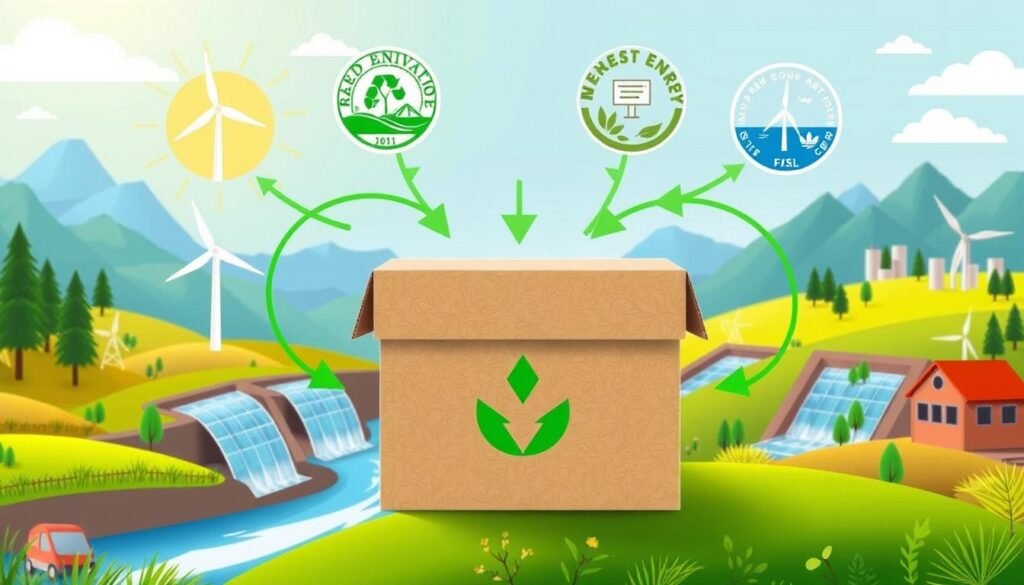
The world of renewable energy is changing fast. More businesses want Renewable Energy Qualifications to show they care about the planet. These certifications are key to being seen as top in clean energy.
Renewable energy standards help companies prove they’re green. They show a company’s effort to cut down on carbon and support green tech.
Solar and Wind Energy Standards
Getting renewable energy certifications means following rules for solar and wind. The main things to do are:
- Check how well things work
- Make sure equipment is good quality
- Follow rules for setting up installations
- Make sure things are safe and reliable
Energy Efficiency Requirements
To get Renewable Energy Qualifications, you need to meet strict energy standards. Companies must show:
- They make energy consistently
- They meet certain tech efficiency levels
- They develop sustainable infrastructure
Certification Maintenance
To keep renewable energy certifications, you need to keep up the effort. You must have regular checks, reviews, and updates to your tech. This keeps your certification and shows you’re a leader in green energy.
Companies that pass these tests get ahead. They become leaders in green energy solutions.
Waste Minimization and Circular Economy Practices
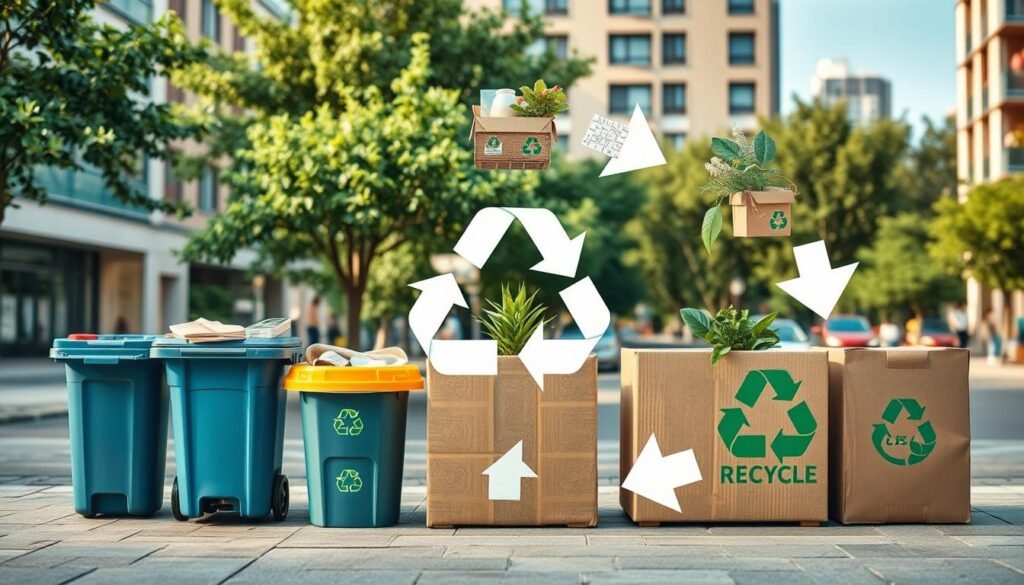
Today, businesses are changing how they think about sustainability. They’re using new Waste Minimization Accreditations and Circular Economy Endorsements. These methods turn old ways of making things into new, green systems. They help the planet and make money too.
Companies that follow the circular economy have three main goals:
- Eliminate waste and pollution
- Circulate products and materials
- Regenerate natural systems
The custom corrugated box industry shows how these goals work. They make boxes that use less waste and help the environment. Circular Economy Endorsements give businesses a plan to change how they work.
| Waste Minimization Strategy | Environmental Impact | Economic Benefit |
|---|---|---|
| Recycling Materials | Reduced Landfill Waste | Lower Raw Material Costs |
| Product Redesign | Decreased Carbon Footprint | Increased Resource Efficiency |
| Closed-Loop Systems | Minimal Resource Consumption | Enhanced Brand Reputation |
Companies that go for Waste Minimization Accreditations can really cut down on their harm to the environment. They also create new, smart ways to do business. This gives them a big advantage in the market.
The Role of Third-Party Verification in Sustainability

Certifications for sustainable practices are key in proving environmental claims. They make sure businesses are accountable. Third-party checks help keep things transparent and trustworthy in sustainability.
Companies wanting real sustainability proof must go through tough outside checks. These checks find areas for growth and show real commitment to the environment.
Auditing Processes
Third-party auditors do deep checks on sustainability. They use many ways to do this:
- Detailed document review
- On-site facility inspections
- Employee interviews
- Supply chain analysis
Compliance Monitoring
Keeping up with sustainability standards is key. This is done through regular checks and tracking how well businesses do.
| Monitoring Stage | Key Activities |
|---|---|
| Initial Certification | Comprehensive evaluation of sustainability practices |
| Annual Review | Verification of continued compliance and progress |
| Periodic Re-Assessment | Detailed audit of evolving sustainability strategies |
Reporting Requirements
Businesses must share clear info on their green efforts. This includes detailed reports on environmental impact, carbon footprint, and goals for being greener.
- Annual sustainability reports
- Greenhouse gas emissions documentation
- Resource consumption metrics
- Waste reduction strategies
Third-party checks turn sustainability into something real and measurable. This helps businesses make real changes for the environment.
Economic Benefits of Sustainable Certifications
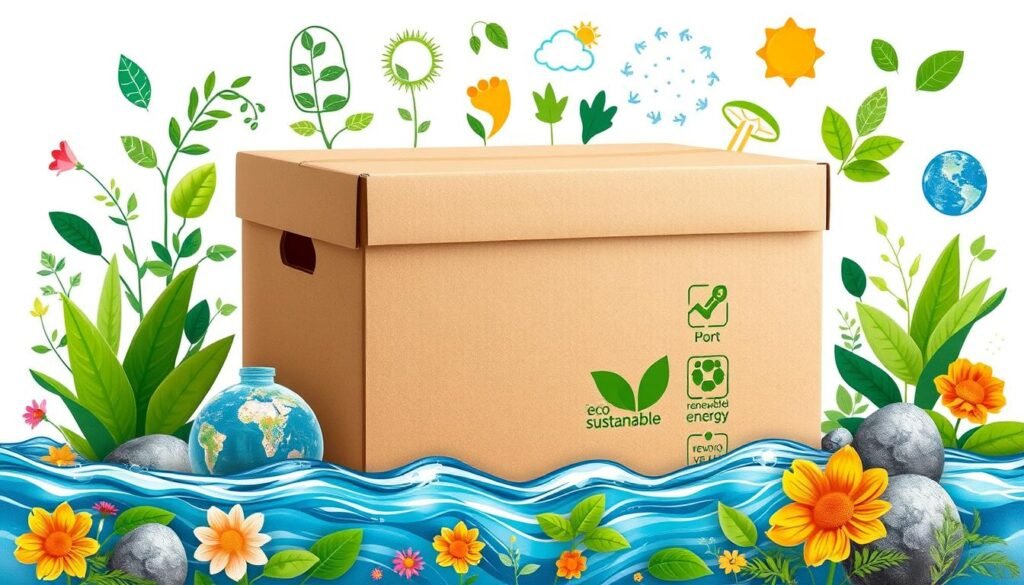
More and more businesses see the big economic wins of going green. These green certifications are more than just good for the planet. They’re smart moves that boost a company’s bottom line and keep it ahead of the competition.
Companies that go green save a lot of money by working more efficiently. By using the strategic approach to sustainability, they cut down on waste and use less energy. This means they get more out of what they have.
- Reduced operational expenses
- Improved resource management
- Enhanced brand reputation
- Increased customer loyalty
Studies show that green companies do well financially. They attract more investors, have lower risks, and stand out in the market.
The benefits of going green go beyond saving money right away. Green businesses often see:
- Higher market valuation
- Stronger stakeholder relationships
- Access to green investment opportunities
- Competitive differentiation
By choosing to go green, companies turn caring for the planet into a big economic plus. It shows that being eco-friendly can really help a business grow financially.
Future Trends in Sustainability Certification
The world of sustainable business is changing fast. Certifications for promoting sustainable practices are getting better. This is thanks to new tech and global environmental issues.
New trends in sustainability certification are changing how businesses act. These changes show a bigger commitment to real sustainable practices.
Emerging Standards
New standards are coming to tackle tough environmental problems. Companies are moving beyond old ways to tackle sustainability.
- Advanced carbon tracking methodologies
- Comprehensive social impact assessments
- Integrated ecosystem health evaluations
Technology Integration
Digital tech is changing Certifications on Promoting Sustainable Practices. AI and blockchain are making sustainability reports more clear and accurate.
- AI-powered emissions tracking
- Blockchain verification systems
- Real-time environmental performance monitoring
Global Harmonization Efforts
International groups are working on common certification standards. They want to make sure sustainable practices are measured the same way everywhere. This will help make a bigger global difference.
The future of sustainability certification is about working together. It’s about using new tech, setting clear standards, and global teamwork. Businesses that follow these trends will be leaders in being green.
Conclusion
The journey to sustainable business practices is key. Certifications for promoting sustainability are powerful tools for companies. They help measure, implement, and verify environmental efforts across various industries.
Today, businesses see sustainability as essential, not optional. By following certification standards for environmental management, companies can change their ways. They can lower their carbon footprint and make a real difference.
Certifications do more than protect the environment. They also drive innovation and boost a company’s reputation. This makes them stand out in markets that care about the planet.
Looking ahead, businesses should see sustainability certifications as chances for growth. They are the first step towards making a real change. This change comes from actions that focus on sustainable development in all areas.


